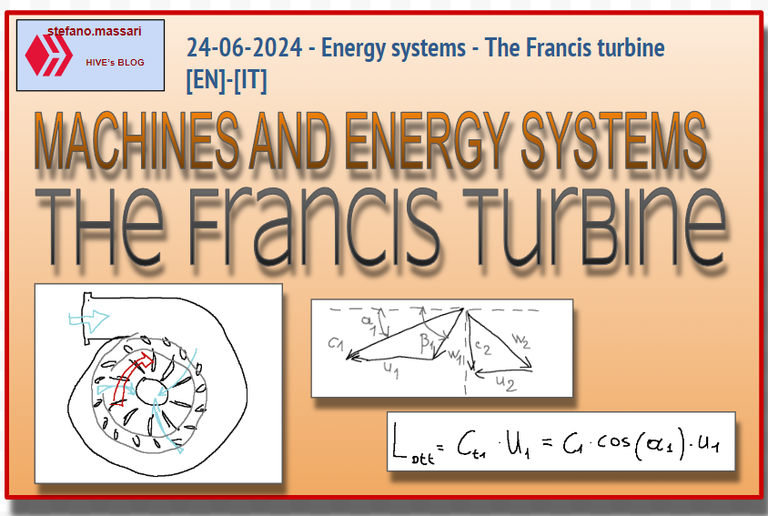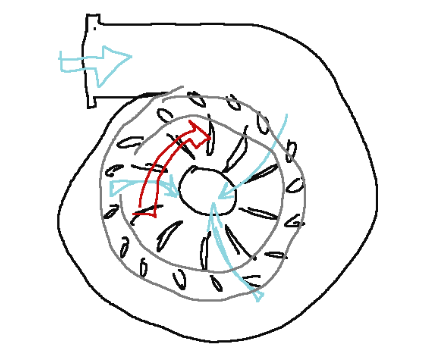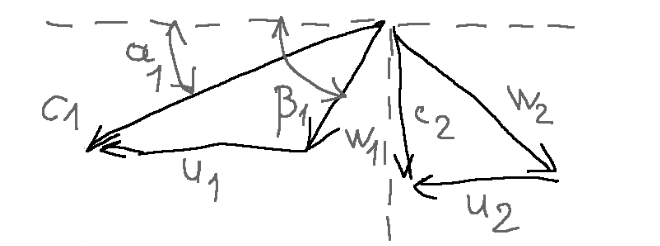24-06-2024 - Energy systems - The Francis turbine [EN]-[IT]

~~~ La versione in italiano inizia subito dopo la versione in inglese ~~~
ENGLISH
24-06-2024 - Energy systems - The Francis turbine [EN]-[IT]
The Francis turbine
Constructive architecture
The Francis turbine is a hydraulic reaction turbine developed around 1850 by an English naturalized American engineer, James B. Francis. This turbine model is among the most used types of hydroelectric turbine in the world
Below is a sketch of the construction architecture of a Francis turbine.

This turbine is a hydraulic driving machine, i.e. where the fluid gives energy to the moving parts of the machine. It is a closed-vein reaction machine, that is, without points of contact with the atmosphere.
She has:
-a snail distributor that distributes the water over the entire periphery of the machine.
-a bladed distributor that directs the fluid to the impeller
-an impeller. Here the fluid passes from a predominantly radial direction to an axial one.
-A diffuser that also allows you to exploit the head downstream of the turbine.
Speed triangles
Below are the speed triangles at the inlet and outlet of the impeller of a Francis turbine.

The Francis turbine, compared to the Pelton turbine, could have a higher rotation speed for the same impeller diameter
The work of the Francis turbine
The work collected by the impeller of a Francis turbine in optimal operating conditions is represented by the following formula.

NOTE:
In a Francis turbine we can see how the pressure also decreases in the impeller, until it drops below atmospheric pressure. This can cause problems related to cavitation in the exit region of the impeller itself.
Speed coefficient
The peripheral speed coefficient Kp is represented by the following formula.

Degree of reaction
The degree of reaction of a Francis turbine is as follows:

The degree of reaction, in general, gives an indication of where most of the energy transformation occurs.
The degree of reaction of a Francis turbine is the parameter that describes the distribution of the transformation of potential energy into kinetic energy and mechanical work inside the turbine.
Conclusions
In the impeller of a Francis turbine the fluid at the inlet has a radial direction, while at the outlet it has an axial direction.
Request
Did you know Francis turbines? Have you already heard of the engineer James B. Francis in the past?

ITALIAN
24-06-2024 - Sistemi energetici - La turbina Francis [EN]-[IT]
La turbina Francis
Architettura costruttiva
La turbina Francis è una turbina idraulica a reazione sviluppata circa nel 1850 da un ingegnere inglese naturalizzato statunitense, James B. Francis. Questo modello di turbina è tra i tipi di turbina idroelettrica più utilizzati nel mondo
Qui di seguito uno schizzo dell’architettura costruttiva di una turbina Francis.

Questa turbina è una macchina motrice idraulica, cioè dove il fluido cede energia agli organi mobili della macchina. Essa è una macchina a reazione a vena chiusa, cioè senza punti di contatto con l’atmosfera.
Essa ha:
-un distributore a chiocciola che distribuisce l’acqua su tutta la periferia della macchina.
-un distributore palettato che indirizza il fluido alla girante
-una girante. Qui il fluido passa da una direzione prevalentemente radiale ad una assiale.
-Un diffusore che consente di sfruttare anche il salto a valle della turbina.
I triangoli delle velocità
Qui di seguito sono rappresentati i triangoli delle velocità all’ingresso e all’uscita della girante di una turbina Francis.

La turbina Francis, rispetto alla turbina Pelton, potrebbe presentare una velocità di rotazione maggiore a parità di diametro della girante
Il lavoro della turbina Francis
Il lavoro raccolto dalla girante di una turbina Francis in condizione di funzionamento ottimale è rappresentato dalla seguente formula.

NOTA:
In una turbina Francis possiamo notare come la pressione diminuisca anche nella girante, sino a scendere al di sotto della pressione atmosferica. QUesto può causare l’insorgere di problemi legati alla cavitazione nella regione di uscita della girante stessa.
Coefficiente di velocità
Il coefficiente di velocità periferica Kp è rappresentato dalla seguente formula.

Grado di reazione
Il grado di reazione di una turbina Francis è il seguente:

Il grado di reazione, in generale, fornisce un'indicazione su dove avviene la maggior parte della trasformazione dell'energia.
Il grado di reazione di una turbina Francis è il parametro che descrive la distribuzione della trasformazione dell'energia potenziale in energia cinetica e lavoro meccanico all'interno della turbina.
Conclusioni
Nella girante di una turbina Francis il fluido all’ingresso ha una direzione radiale, mentre all’uscita ha una direzione assiale.
Domanda
Conoscevate le turbine Francis? Avete già sentito parlare in passato dell'ingegnere James B. Francis?
THE END
Congratulations @stefano.massari! You have completed the following achievement on the Hive blockchain And have been rewarded with New badge(s)
You can view your badges on your board and compare yourself to others in the Ranking
If you no longer want to receive notifications, reply to this comment with the word
STOPThe shift from radial to axial flow is particularly interesting to me. It's amazing that technology from the 1850s is still so relevant today wow
The Francis turbine is a great course and I’m glad you gave us an idea on what it looks nice
Nice topic!
This course is an interesting one but quite difficult
The formulas were difficult
!discovery 35
This post was shared and voted inside the discord by the curators team of discovery-it
Join our Community and follow our Curation Trail
Discovery-it is also a Witness, vote for us here
Delegate to us for passive income. Check our 80% fee-back Program
Keep up the good work. 👏
You deserve the best. 💪
Curated by the Mystic Gudasol